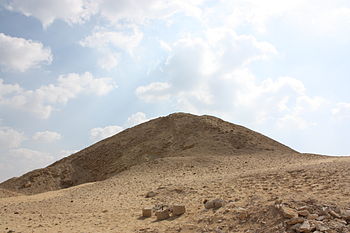Pyramid of Teti
| Pyramid of Teti | |||||||||||||||
|---|---|---|---|---|---|---|---|---|---|---|---|---|---|---|---|
 |
|||||||||||||||
| Teti | |||||||||||||||
| Coordinates | 29°52′31″N 31°13′18″E / 29.87528°N 31.22167°ECoordinates: 29°52′31″N 31°13′18″E / 29.87528°N 31.22167°E | ||||||||||||||
| Ancient name |
Ḏd-jswt-Ttj Djed-isut-Teti Teti's Places Are Enduring |
||||||||||||||
| Constructed | Sixth Dynasty | ||||||||||||||
| Type | Smooth-sided Pyramid | ||||||||||||||
| Height | 100 cubits (45.72 m) | ||||||||||||||
| Base | 150 cubits (68.58 m) | ||||||||||||||
| Slope | 53° 07' 48" | ||||||||||||||
The Pyramid of Teti is a smooth-sided pyramid situated in the pyramid field at Saqqara in Egypt. It is historically the second known pyramid containing pyramid texts. Excavations have revealed a satellite pyramid, two pyramids of queens accompanied by cult structures, and a funerary temple. The pyramid was opened by Gaston Maspero in 1882 and the complex explored during several campaigns ranging from 1907 to 1965. It was originally called Teti's Places Are Enduring. The preservation above ground is very poor, and it now resembles a small hill. Below ground the chambers and corridors are very well preserved.
The pyramid complex of Teti follows a model established during the reign of Djedkare Isesi, the arrangement of which is inherited from the funerary complexes of Abusir.
A valley temple, now lost, was probably destroyed in antiquity due to the place of an Old Kingdom temple dedicated to Anubis constructed there. A better known funerary temple revealed by James Edward Quibell in 1906, is connected to the valley temple by a causeway. The plan of the temple of Teti is also comparable in many respects to that of Unas, which is its immediate predecessor. Teti's temple has a somewhat special plan, however, due to a deviation of the floor which traditionally should have been located in the axis of the temple but here is moved south. It then accesses the temple through a hallway of the north–south facade joining the east–west axis of the monument. Followed in this main axis is a second hall. The thickness of the walls suggests a vaulted cover. It was probably the Room of the Greats, on the walls of which the royal family and influential members of the court were to be represented assisting and accompanying the eternal journey of their sovereign.
This hall opened into an open courtyard surrounded on all four sides by colonnades whose main purpose was the presentation of daily offerings and ritual libations. The only way out is centered to the west and provides access to the innermost part the sanctuary.
Included in the Peribolos, a sacred part of the royal pyramid reserved for priests of the king, was a chapel containing the five Naos, housing five statues of the King appearing in the aspect of the five principal deities of the realm. This part also included a private room containing the false door stela of the King, a veritable object of funeral worship, and a double row of stores on both sides of the axis of the temple. The first row frames the party host and is accessible by a long corridor along the entire width of the building that leads to the south and north within the peribolos of the pyramid. The second set frames the sanctuary and the hall of statues of gods and was only accessible from the latter.
...
Wikipedia
